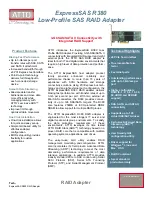
136 Managing administrative domains
Managing admin domains
This section is for physical fabric administrators who are managing Admin Domains. You must be a
physical fabric administrator to perform the tasks in this section.
•
”
Implementing admin domains
” on page 137
•
”
Creating an admin domain
” on page 137
•
”
Assigning a user to an admin domain
” on page 138
•
”
Activating and deactivating admin domains
” on page 139
•
”
Adding and removing admin domain members
” on page 140
•
”
Renaming an Admin Domain
” on page 141
•
”
Deleting an Admin Domain
” on page 141
•
”
Deleting all user-defined Admin Domains
” on page 142
•
”
Validating an Admin Domain member list
” on page 142
Understanding the AD transaction model
This section summarizes the
ad
command. This command follows a batched-transaction model, which
means that changes to the Admin Domain configuration occur in the transaction buffer.
An Admin Domain configuration can exist in several places:
•
Effective configuration
—The Admin Domain configuration that is currently in effect.
•
Defined configuration
—The Admin Domain configuration that is saved in flash memory. There
might be differences between the effective configuration and the defined configuration.
•
Transaction buffer
—The Admin Domain configuration that is in the current transaction buffer and
has not yet been saved or canceled.
How you end the transaction determines the disposition of the Admin Domain configuration in the
transaction buffer. The following commands end the Admin Domain transaction:
ad --save
Saves the changes in the transaction buffer to the defined configuration in persistent storage and
propagates the defined configuration to all switches in the fabric. Note that for delete and clear
operations, if one or more of the deleted Admin Domains are in the effective configuration, you cannot use
--save
, but must use
--apply
instead.
ad --apply
Saves the changes to the defined configuration in persistent storage and enforces the defined configuration
on all switches in the fabric, replacing the effective configuration.
ad --transabort
Aborts the transaction and clears the transaction buffer. The effective and defined configurations remain
unchanged.
You can enter the
ad --transshow
command at any time to display the ID of the current Admin Domain
transaction.
Detailed information about CLI syntax and options is available in the
Fabric OS Command Reference
Manual.
Summary of Contents for AE370A - Brocade 4Gb SAN Switch 4/12
Page 18: ...18 ...
Page 82: ...82 Managing user accounts ...
Page 102: ...102 Configuring standard security features ...
Page 126: ...126 Maintaining configurations ...
Page 198: ...198 Routing traffic ...
Page 238: ...238 Using the FC FC routing service ...
Page 260: ...260 Administering FICON fabrics ...
Page 280: ...280 Working with diagnostic features ...
Page 332: ...332 Administering Extended Fabrics ...
Page 414: ...398 Configuring the PID format ...
Page 420: ...404 Configuring interoperability mode ...
Page 426: ...410 Understanding legacy password behaviour ...
Page 442: ...426 ...
Page 444: ......
Page 447: ......
















































